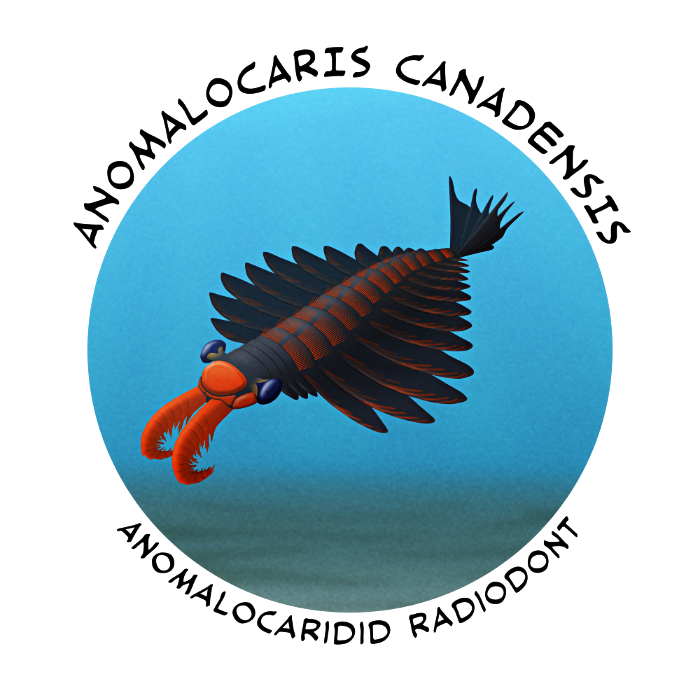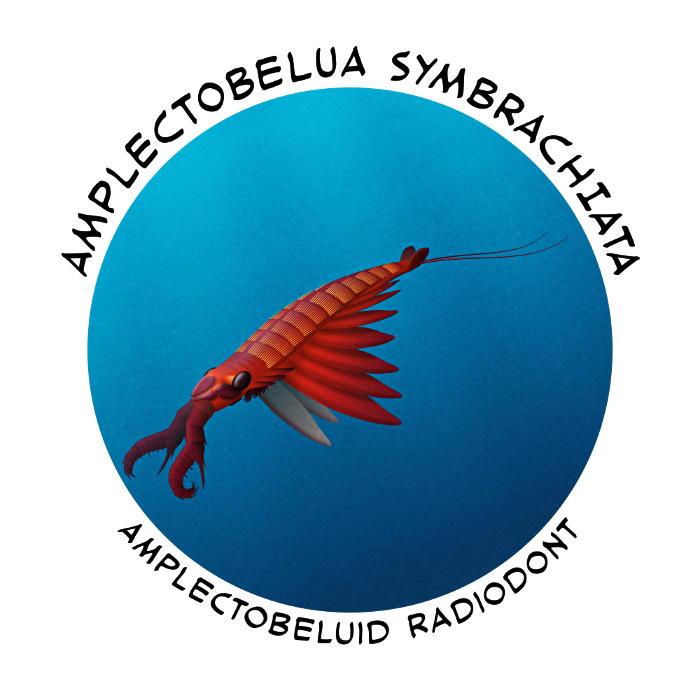Once the dinocaridids started exploring active swimming lifestyles, one branch of this group quickly became incredibly successful and diverse: the radiodonts. With muscular swimming flaps, head carapaces, stalked compound eyes, disc-like mouths, and large spiny front appendages, they occupied a wide range of ecological roles – and some of them went on to became giants, some of the largest animals of their time.
They were some of the closest relatives to the ancestors of the true arthropods (or “euarthropods”). And while the earliest radiodont fossils are known from about 518 million years ago, much like other panarthropods their actual evolutionary origins have to go back much deeper into the early Cambrian since they already lived alongside representatives of various early euarthropod groups.

The first radiodont ever discovered is also the most famous of the group, Anomalocaris canadensis from the Canadian Burgess Shale deposits (~508 million years ago).
Initially discovered in the late 1880s, only isolated front appendages were found and they were misidentified at the time as being parts of crustaceans. In the early 1910s an individual mouth cone was thought to represent a jellyfish, and a fairly complete body fossil was interpreted as a sea cucumber. It wasn’t until 1985 that all these separate pieces were finally recognized as belonging to one type of surprisingly large Cambrian animal, which was given the earliest name assigned to any of the constituent fossils – Anomalocaris, meaning “strange shrimp” – and thankfully that tuned out to be a very fitting name for a bizarre-looking distant cousin of crustaceans and other arthropods.
Since then around 35 different species of radiodonts have been discovered, and Anomalocaris has turned out to represent just one branch of this lineage.
It had 13 pairs of large body flaps and 3 smaller pairs on its neck region, along with a vertical three-part tail fan and rows of hair-like gills attached to each body segment along its back. Its stalked compound eyes were made up of around 16,000 lenses each, and it would have had incredibly sharp vision comparable to modern dragonflies. Several sclerites formed a carapace around its head, with a tri-radial mouth underneath and a pair of large jointed spiny appendages at the front.
While some past estimates of its size are now known to be rather exaggerated (or based on different radiodont species entirely), it was still a relatively huge animal for the time at around 50cm long (1’8″). Its raptorial front appendages suggest it was an apex predator, with a lack of wear on its mouthparts indicating it probably mostly fed on soft-bodied animals.
The closely-related Lenisicaris and several other still-unnamed species of Anomalocaris are known from various mid-Cambrian fossil sites that at the time were tropical or subtropical latitudes, showing that anomalocaridids were widespread in warm waters around the world. Ultimately these predatory radiodonts lasted for at least 20 million years during the mid-Cambrian, with the last known anomalocaridid fossils coming from the Weeks Formation in Utah, USA (~499 million years ago).

Related to the anomalocaridids, the amplectobeluid radiodonts had front appendages with a highly enlarged first spine, forming a specialized grasping pincer-like structure.
Amplectobelua symbrachiata is known from the Chinese Chengjiang fossil deposits (~518 million years ago) and was around the same size as Anomalocaris at about 50cm long (1’8″), making it one of the largest known Chengjiang animals.
It had 11 pairs of large swimming flaps with strengthening rays along their front edges, and while it’s unclear if it had a tail fan it did have a pair of long streamer-like appendages at its rear end. Underneath the smaller pairs of flaps on its neck there were at least 3 pairs of “gnathobase-like structures” that would have been used to hold and shred up prey after transferring it from its pincer-like front appendages, chewing it up before passing it up to its mouth.
Several other amplectobeluids have been identified, including Lyrarapax and Ramskoeldia, and they also seem to have occurred mostly in tropical and subtropical waters during the mid-Cambrian. The latest known fossils of this family come from the Burgess Shale, about 508 million years ago, and much like their cousins the anomalocaridids they may have been wiped out around the time of the late Cambrian “SPICE” event, unable to cope with cooling oceans and rising anoxic conditions.
